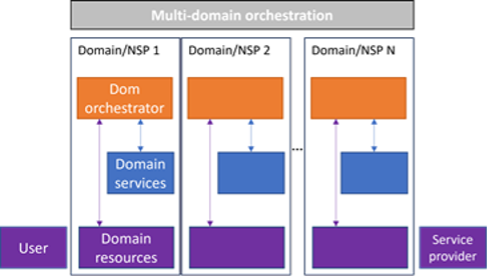
As the world intensifies its efforts to mitigate the escalating impacts of climate change, the Information and Communication Technology (ICT) sector is facing mounting pressure to reduce its carbon footprint. With projections indicating that ICT could account for up to 20% of global CO₂ emissions by 2030, the urgency for sustainable solutions has reached unprecedented levels [1]. The sector must innovate rapidly to align with global decarbonisation goals, particularly as digital transformation accelerates across industries.
Although 6G is still in its embryonic stage, it is widely anticipated that multi-stakeholder and multi-domain networks will play a pivotal role in enabling end-to-end (E2E) service delivery within the ICT vertical industry [2]. These networks will span across heterogeneous administrative domains, involving multiple stakeholders to expand service coverage and enhance connectivity. While research efforts are focused on intra-domain decarbonisation [3], the future of ICT will face novel challenges in energy and carbon monitoring, as well as carbon-aware E2E management, particularly in multi-domain scenarios. These challenges will require innovative solutions to ensure sustainability without compromising performance or interoperability.
Exclusive challenges of carbon-aware multi-domain network orchestration
- Energy/carbon monitoring: Under the fact that most of the existing energy/carbon monitoring efforts have been focusing on intra-domain scenarios, energy/carbon monitoring for multi-domain network orchestration faces unique challenges. For instance, inter-domain energy/carbon monitoring, as well as its responsibility, lacks sufficient standardisation to achieve consensus among stakeholders. This absence of standardisation complicates the collection and analysis of energy and carbon-related metrics, which are critical for effective E2E multi-domain network orchestration. Based on the diverse nature of service providers involved in multi-domain service delivery (e.g., network service providers (NSPs) for data transmission, edge/cloud operators for data storage/processing, etc.), the metrics used by them might vary depending on their needs. However, biased decisions might be made by the multi-domain network orchestrator if the stakeholders adopt different metrics. Proper energy/carbon-related metrics to be considered in network orchestration also directly affect the orchestration performance. For example, while energy consumption reduction is closely tied to decarbonisation, it does not fully account for the use of green energy sources. Conversely, over-reliance on carbon metrics could result in the excessive use of renewable energy, potentially straining these resources. Therefore, establishing a balanced set of metrics is crucial to achieving both energy efficiency and decarbonisation goals.
- Network orchestration strategies specifically for Multi-domains/stakeholders: Multi-domain network orchestration faces inherent limitations, as it cannot directly control the intra-domain management of individual stakeholders. At best, it can provide preferential guidance, which may not always align with the priorities of each domain. Additionally, the involvement of multiple stakeholders in E2E service delivery necessitates a decentralized approach to orchestration. However, current ICT systems, primarily based on 4G and 5G technologies, lack robust mechanisms for establishing trustworthy and cost-effective interfaces among stakeholders. While cutting-edge decentralised orchestration solutions, such as those leveraging blockchain or advanced cryptography [4], show theoretical promise, they often rely on centralised “trusted” third-party coordinators in practice. This reliance not only increases operational costs but also raises concerns about data privacy. Stakeholders’ energy and carbon-related data, which may include sensitive operational information, must be shared for decision-making purposes. However, such data sharing is often impractical, as it could expose trade secrets or proprietary information. These challenges underscore the need for innovative solutions that balance decentralisation, privacy, and cost-effectiveness.
Carbon-Aware Multi-Domain Network Orchestration: The Need for Appropriate Metrics
The aforementioned challenges reveal that appropriate metrics are needed, which should not only incorporate traditional energy-related metrics but also take into account carbon emissions. Therefore, the stakeholders might have to adopt energy efficient strategies and pursue “cleaner” solutions, simultaneously. Here are some examples of the related metrics: i) traditional metrics that measure energy consumption: power (W) and energy (J); ii) metrics that measure energy consumption under data traffic (but might overlook idle operations): data-aware energy efficiency (J/B); iii) carbon-aware metrics that link carbon emissions to energy consumption: carbon intensity (g/J); iv) carbon and data-aware metrics that measure carbon emissions per unit of transmitted data; data-aware carbon footprint (g/B).
Other energy/carbon-related metrics that can be considered in ICT could be easily classified into these categories. State-of-the-art research shows that more than 90% of decisions could be biased when the stakeholders in multi-domain network orchestration adopt different and inappropriate metrics [5]. Therefore, research points out that it might be essential to adopt multiple metrics for carbon-aware multi-domain network orchestration to overcome the aforementioned challenges for energy/carbon monitoring. Besides, metric determination might also need to be dynamic, depending on the services being handled, e.g., there is no need to consider data-aware metrics when the services are not “traffic intensive.”
Multi-Domain Network Orchestration: The Need for Full Decentralisation
Collaboration among multiple stakeholders (also known as service providers) to support E2E service delivery of multi-domain ICT is essential. It has been acknowledged that interoperability of multiple domains potentially leads to improved service quality with higher resource utilisation efficiency. However, carbon-aware network orchestration among multiple domains with different services, owned by different stakeholders, requires the current orchestration strategies to be upgraded. Regarding the challenges mentioned earlier, some cutting-edge solutions decentralise the orchestration without relying on centralised parties/controllers [6].

Figure: Generic framework of multi-domain network orchestration.
In particular, there are attempts to fully decentralise the orchestration: The orchestrators are distributed to domains/stakeholders, eliminating centralisation [1]. Besides, these distributed orchestrators converge and update the orchestration strategies without relying on the stakeholders’ privacy-sensitive data, e.g., real-time operation status, carbon emissions, etc. Instead, it is sufficient to reach optimal inter-domain orchestration by sharing stakeholders’ privacy-insensitive data (e.g., international calculators, multipliers) with each other. In fact, the feasibility of the solution has already been discussed and analysed with simulations.
Conclusion
To pave the way for a “Green 6G” future, this post highlights two essential and urgent needs for carbon-aware solutions in multi-domain network orchestration. First, energy/carbon monitoring should be emphasised, which requires consensus on measuring methods and metrics among the stakeholders. Otherwise, it would cause significant bias in the carbon-aware orchestration decisions among multiple domains. On top of the measured data, orchestration among multiple domains should also be distinguished from conventional single-domain orchestration and multi-domain solutions that do not consider the property and privacy of the stakeholders. This post recommends the emerging method of fully-decentralised network orchestration, where the orchestrators are distributed to individual domains (fully eliminating centralised controllers/parties), meanwhile only sharing the domains’ privacy-free data with each other. By doing so, the stakeholders would be incentivised toward high interoperability. Therefore, this post provides a glimpse of reducing the carbon footprint of ICT, particularly focusing on multi-domain network orchestration.
References
[1] H. R. Chi, D. Corujo and R. L. Aguiar, “Carbon-Aware Full-Decentralized Multi-Provider Edge Computing Peer Offloading,” 2024 IEEE 22nd International Conference on Industrial Informatics (INDIN), Beijing, China, 2024, pp. 1-6, doi: 10.1109/INDIN58382.2024.10774500.
[2] R. Direito, D. Gomes, J. Alegria, D. Corujo, and D. Gomes, “Netor: A microservice oriented inter-domain vertical service orchestrator for 5g networks,” Journal of Internet Services and Applications, vol. 14, no. 1, pp. 136–150, 2023. DOI: 10.5753/jisa.2023.3207.
[3] N. Zilberman, et al., “Toward carbon-aware networking,” SIGENERGY Energy Inform. Rev., vol. 3, no. 3, pp. 15–20, Oct. 2023. DOI: 10.1145/3630614.3630618.
[4] G. He, W. Su, S. Gao, N. Liu and S. K. Das, “NetChain: A Blockchain-Enabled Privacy-Preserving Multi-Domain Network Slice Orchestration Architecture,” in IEEE Transactions on Network and Service Management, vol. 19, no. 1, pp. 188-202, March 2022, doi: 10.1109/TNSM.2021.3110057.
[5] H. R. Chi, D. Corujo, A. Radwan, and R. L. Aguiar, “Metric Impact Towards Carbon-Aware Multi-domain Network Orchestration,” IEEE GLOBECOM 2024, Cape Town, South Africa, (Accepted).
[6] P. Zhang, N. Chen, S. Li, K.-K. R. Choo, C. Jiang, and S. Wu, “Multi-domain virtual network embedding algorithm based on horizontal federated learning,” IEEE Transactions on Information Forensics and Security, vol. 18, pp. 3363–3375, 2023. DOI: 10.1109/TIFS.2023.3279587.
Author

Instituto de Telecomunicações
Haoran Chi is a researcher in the Instituto de Telecomunicações, Portugal. He has obtained expertise on 5G (beyond) telecommunication, network management and optimisation, and machine learning. He has plenty of experience in European project management. He is also proactive in scientific community, serving as the Associate Editor of multiple IEEE journals, the Secretory of IEEE IES TC BACM, and Chair/co-Chair of multiple IEEE Standards.

